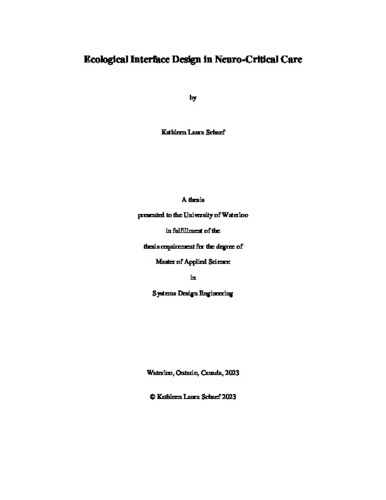| dc.contributor.author | Schaef, Laura Kathleen | |
| dc.date.accessioned | 2023-05-02 12:58:34 (GMT) | |
| dc.date.available | 2023-05-02 12:58:34 (GMT) | |
| dc.date.issued | 2023-05-02 | |
| dc.date.submitted | 2023-04-27 | |
| dc.identifier.uri | http://hdl.handle.net/10012/19386 | |
| dc.description.abstract | Neuro-critical care is a data-intensive environment that requires physicians to integrate information
across multiple screens, sources, and software. Despite the advances in neuromonitoring techniques,
interfaces that allow for viewing and analyzing of historic data are not common. However, historical
data is critical to identify patterns important for patient care. Instead, physicians view the trends of a
patient’s neurophysiological variables by continuously watching the bedside monitor or they rely on
checking the paper (or digital) charts for a patient where variables have been recorded periodically
(usually once an hour). In neuro-critical care, physicians need to understand the historic and current
state as well as predict the future state of intracranial pressure (ICP). ICP is the most monitored brain-specific physiologic variable in the Intensive Care Unit (ICU) and is considered a biomarker for
secondary brain injury. As a result, ICP would benefit greatly from showing key patterns important to
patient state and care.
The ICU is a stressful, dynamic, and time-sensitive environment where the performance of physicians
and their ability to correctly diagnose and manage patient treatment has a significant impact on
patient outcomes. Physicians rely on the bedside physiologic monitor to detect changes in physiologic
variables. The monitor must provide the information required to understand the patient’s condition so
physicians can determine the optimal treatment plan. With the high cognitive demands and complex
sociotechnical environment of the ICU, an opportunity exists for improved neuro-critical care
monitoring to support physicians’ decision-making. Ecological Interface Design (EID) is an approach
to interface design that has proven effective for complex, sociotechnical, real-time, and dynamic
systems. Research suggests that an EID approach combined with user-centered design has a positive
impact on performance, especially in unfamiliar scenarios.
The objective of this research is to explore an EID design approach combined with user-centered
design to enhance the bedside physiologic monitor through the addition of visualizations that help
support physicians' understanding of complex relationships and concepts in neuro-critical care. The
hope is that providing more-advanced visualizations on the bedside physiologic monitor will lead to
improved situation awareness, decreased mental workload, and expertise development acceleration of
novice clinicians in the neuro-ICU.
The work presented in this thesis builds on the Cognitive Work Analysis (CWA) and observations in
the ICU already completed by Uereten et al (2020). The design of the visualizations for use on the
bedside physiologic monitor was highly iterative and involved the inputs from the CWA and
observations as well as ongoing feedback and focus areas provided by Dr. Victoria McCredie, our
clinical collaborator and critical care physician at Toronto Western Hospital. The visualizations were
evaluated and validated in semi-structured interviews with trainees (fellows) and experts (staff
physicians) in neuro-critical care. The semi-structured interviews with trainees were used as a
preliminary usability assessment of the visualizations and the interviews with staff physicians were
used to iterate and refine the designs. The results from both sets of interviews were used to create a
final design prototype that is currently being tested in a usability study with trainee physicians
(January-March 2023). | en |
| dc.language.iso | en | en |
| dc.publisher | University of Waterloo | en |
| dc.title | Ecological Interface Design in Neuro-Critical Care | en |
| dc.type | Master Thesis | en |
| dc.pending | false | |
| uws-etd.degree.department | Systems Design Engineering | en |
| uws-etd.degree.discipline | System Design Engineering | en |
| uws-etd.degree.grantor | University of Waterloo | en |
| uws-etd.degree | Master of Applied Science | en |
| uws-etd.embargo.terms | 0 | en |
| uws.contributor.advisor | Burns, Catherine | |
| uws.contributor.affiliation1 | Faculty of Engineering | en |
| uws.published.city | Waterloo | en |
| uws.published.country | Canada | en |
| uws.published.province | Ontario | en |
| uws.typeOfResource | Text | en |
| uws.peerReviewStatus | Unreviewed | en |
| uws.scholarLevel | Graduate | en |

